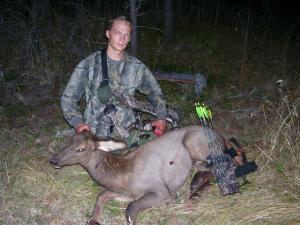Elk Hunting Tips
Elk Hunting Tips
The Animal:
Elk are one of the most majestic creatures to hunt. Elk hunting isn’t something you can learn after hearing hunting stories, this type of thing can only be perfected with real field experience. Large males can be upwards of 900lbs. Elk have a large kill zone but can run quite aways after being shot with a good hit. Cows are a light brown colour while a calf can be a chocolate colour. When a bull is mature he will be a cream colour with a dark brown main. They have impressive racks and antler configurations. Mature bulls will have 6 points a side or more. the early morning bugles are sure to raise your adrenaline, and when they respond to your calling you are sure to be hooked on elk. Before you go on your hunting trip make sure you do your pre season scouting for the elk hunt. Elk are very tastey and once you bring the meat home from the butcher, be sure to try some great Elk Meat Recipes.
Elk need water at least 2x a day so if you find a good watering hole with a lot of sign you might want to keep a close eye as they will most likely come back after feeding/ bedding times. First and last light will be the time to spot these animals feeding. If up high, pay attention as they move between strips of timber in the alpine meadows and pockets to find there browse. It is your best chance to spot them. If hunting lower elevations you will be able to spot them in fields grazing and open meadows with timbered areas around for safety. This is where high quality optics come in to play.
The Season:
The elk is a herd animal that migrates during the winter. During the early season in September before the rut begins the mature bulls will be up high in timber pockets and in alpine meadows. The spike and satellite bulls will be tending the cow and calf herds until the big bulls come down to claim there harem by the middle of September. By Octobers end, the bull elk are tired from fighting and bugling and will be thinking of eating and getting healthy before the winter begins. Bulls can be taken post rut but they will be retreating due to the tiresome battle and lack of food during the rut.
Calling Strategies:
A good place to start calling is in your living room well before hunting season begins. Learn your cow, calf, and bull calls. I suggest having a few different calls before heading out. I use a cow girl, hoochie momma, mouth calls, and I have a primos bull grunt tube. You want to have different sounds to emulate a herd. Elk will know something is wrong if there is only one type of call. I have had much greater success making sounds with my hoochie momma, while making  mouth calls, and switching it up to simulate a herd. Only use a bull bugle to locate a bull or a herd because you might scare a bull off when in close. Cow calling and cherping is always your best bet as a rule of thumb.
mouth calls, and switching it up to simulate a herd. Only use a bull bugle to locate a bull or a herd because you might scare a bull off when in close. Cow calling and cherping is always your best bet as a rule of thumb.
Using a primos mouth call combined with a hoochie momma hand call, lured this calf elk in for my 1sr elk kill during archery season.
Use the bugle as a last resort if the bulls will not respond to the cow calling. If you locate a herd and have a stalk planned out that looks good. Don’t call. Just move in slow and take your shot. You never know, you could blow them off into the next range if they don’t respond positively to the calling, especially in close quarters.
Scent Management:
This is very important! I remember calling and communicating with herds but they would not come in. I used the elk scent wafers, attached it to my hat and that made the difference. The next day the very same herd moved in and I managed to bag my very first elk and with a bow to boot.
I use fall blend spray to cover my human scent along with scent soaps and of course wash my clothes with a scent removing detergent. Then finally I attach the scent wafers to simulate the sweet smell of elk. When not hunting I then put the hat with the scent wafer in a Ziploc bag as they seriously reek!
Field Judging
I will give you a couple quick tips here but the best way to learn is by watching lots of footage and seeing there scores. A good way to quickly determine if the bull is a 6 point, would be to look at the back of the bulls antlers and if there is a crab claw he is a 6 point. The larger the crab claw the better chance that he is a bigger bull. You can also quickly use the relation of body size to antler size. If the antlers look like they are too big in proportion to the bull then it’s a shooter. Main beam length and tine length will give you good points to your score. If the antlers look like they go far down the back of the elk, he is a shooter. From a far distance, if the elk is almost white in colour with a dark main, most likely it is a mature bull.

